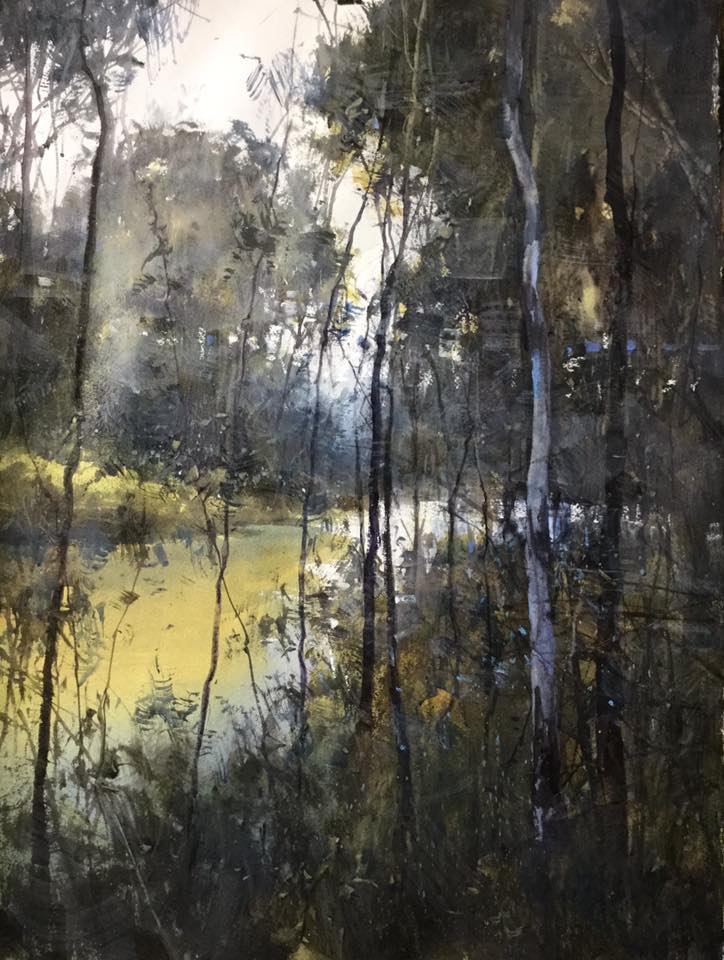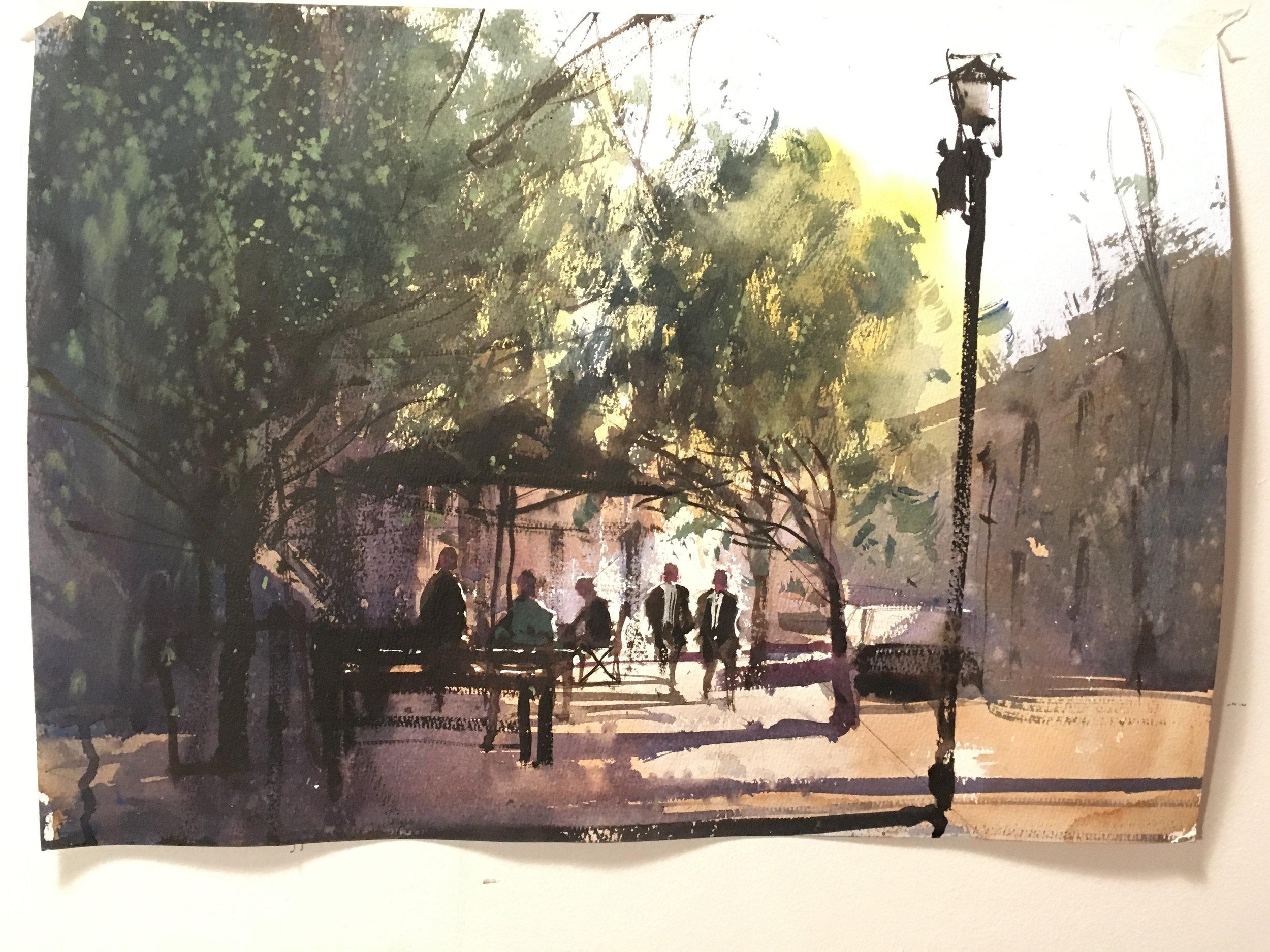Workshop Review- Herman Pekel, pt. 1
In late August, I took a 4 day workshop with Herman Pekel up in Vancouver, through Artescapes YVR again. I like his scruffy, loose brushwork, and the fact that he paints unabashed, full-throated nature scenes. I was also interested in Pekel's dynamic use of color- his vibrant yellow-oranges, cool blue-greens, and his rich, chromatic darks- as previous teachers, such as Zbukvic and Chien, have focused on a muted usage of color. And, truthfully, Joseph also recommended him as a teacher when I said I was interested in learning more about composition.
Pekel is part of the infamous Australian “three amigos” that includes Joseph Zbukvic and Alvaro Castagnet, as well as the “Winterlude” group that Joseph sometimes speaks of. As such, certain basics of Herman's approach have a lot in common with the other two. His darks are thick and very dark for watercolors, he paints in only a few quick layers, and his brushstrokes are definitively applied with gusto and abandon.
Herman himself is a scrappy sort of fellow. Very mellow and self-effacing, a little scattered and prone to losing his train of thought, but also funny and honest and very direct when discussing art. As a teacher, he was sometimes all over the place, starting a demo and winging it or mentioning one thing at one moment and then moving off to another idea the next, but Joseph recommended Pekel as a teacher because of my interest in improving my compositions, and on this, in particular, his advice was very sound. Over the course of the four days, a series of important repeated motifs came up again and again and again… and again. :P
Here are what I see as the key Pekel aphorisms. Drilled into my brain through much repetition! :D
On Focal Points-
Always find an excuse for a patch of white.
“Find a reason for a strong focal point. Find a patch of white. Even if you stuff it up, it’ll still hold together. That patch of white will save your life.”
On Washes-
Your first wash is for color and your second is for value.
Pekel’s first washes are often very strong in terms of color. Generally warm colors (yellows and limes and oranges), as the darker second wash is generally cooler shadows. Warm versus cool allows for interesting color contrasts.
On Shapes-
This came down to one basic thing- Try and create two-shape paintings. Weld your darks together and capture the light you created way back when you found “an excuse for a patch of white”.
Paintings Are Like Jokes-
“A focal point is like a punch line. Everything should lead to it. Look for something interesting and build your painting around it.”
Pekel made frequent use of this metaphor, to help us think about our editing choices. Jokes are a communication tool, a story telling tool where we condense the subject matter down to its essentials. Herman’s comments included thoughts such as, “A good joke has only one punchline” and “You should only include those things that are pertinent to the punchline.”
“When you have something for the painting to be about, exaggerate it. Pick one thing and make it dominant. Always exaggerate it. Push it.”
Philosophy-
“Watercolors is more a philosophy than a style of painting. Don’t fight watercolors. Let the water paint it for you. Don’t try too hard.”
When you simplify the set, it all seems so straightforward-
Find something interesting, make it your focal point, and save a patch of white. Do your painting in two washes- one for rich color and one for bold darks. Simplify your darks to fewer and fewer connected shapes. Let your editing choices be dictated by the dominance of your focal point. Exaggerate your focal point. Let the water work for you.
And yet, of course, that’s very hard to do in practice! In truth, that was even the case for Herman. Despite my opinion that, overall, the workshop was full of successful paintings and useful as a learning experience, there were some paintings early on that Herman (in my opinion) struggled with. Watching someone sort of fried from too much travel struggle with painting a subject in public is never fun, but... it was interesting to see him pull something out of what looked like a real wrestle. Particularly because I felt like he headed his own advice- he "found an excuse for a patch of white" and focused everything on making that patch work.
Doing a Demo Twice-
In this demo from Day 2, Herman actually had a different subject in mind, but had to change things at the last moment because a big delivery truck pulled up. He switched positions and started up a new subject on the fly (hard!!!!). Then he kept getting sun on paper, and it was screwing with his values (even harder!!).
He powered through, though. It was a tough, busy subject. It was very interesting to watch him do two things in particular- 1) break up the big flat space of the tree on the left with opaque pale-valued splatters and 2) drop in the darks on the far right and up above the pathway directly. The more he painted, the more he circled the darks around his focal point and made the "patch of white" more and more important. In the end, it did the job.
Herman seemed dissatisfied though, and decided to paint it again when we went inside- this time as a vertical. He did this twice over the first few days of the workshop, and I actually appreciated it, because you got to see him approach the same subject with a shift in focus or an altered game plan. As a bonus, we were more "in on the plan" the second time around and could anticipate a few of his moves. A useful learning tool!
In the next post, I'll be sharing more technical info about Herman's setup- his brushes and paints, and the ins and outs of how he set things up. Interesting stuff for watercolor nerds! I'll also share a few more demos.










